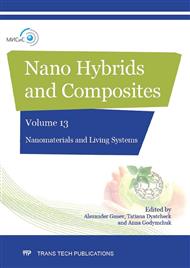p.190
p.199
p.206
p.211
p.219
p.225
p.232
p.239
p.248
Methodological Aspects of the Health Risk Assessment in Application to Safety of Nanomaterial
Abstract:
Results of the health risk (HR) assessment are needed to support decisions on safety of nanotechnologies and practical use of nanomaterials/nanoparticles (NMs/NPs), including establishment of health safety standards (HSSs). To meet these needs HR assessment’ tools are developed using the great experience in the development and application of such tools for other sources of harm (ionizing radiation, chemicals, etc.), accumulated during the last decades. The tools include methodology, computer data bases and calculation codes.Three-level’ scheme of development and application of HR assessment methodology is roposed: general, specific and simplified methods. The general method serves as a basis for development of specific methods, applicable to the concrete harm sources, for development and justification of simplified methods. In this approach the specific method consists of two parts: 1) the general HR assessment method, 2) exposure – response dependences for the harm source considered in the form of age-cause-specific death or diseases coefficients. Such structure of HR assessment methodology in its full development makes specific methods being more transparent and comparable as well as safety decisions based on HR assessment for different harm sources.The proposal is made concerning the special risk index for the risk standardization and comparison. The unified approach is developed to the establishment of the HSSs and other levels of decision-making on people safety with the use of HR risk assessment in different spheres of human activity including nanotechnology and use of NPs/NMs.
Info:
Periodical:
Pages:
219-224
Citation:
Online since:
January 2017
Price:
Сopyright:
© 2017 Trans Tech Publications Ltd. All Rights Reserved
Share:
Citation:


